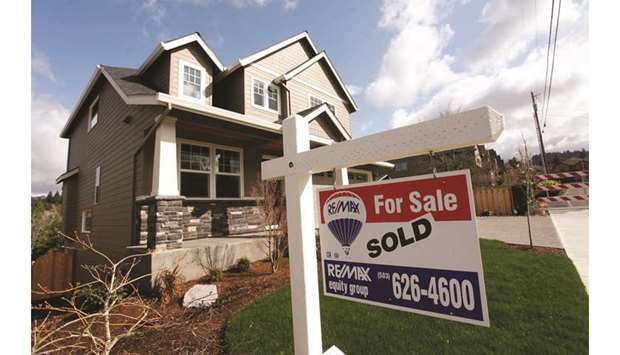But other data yesterday showed the number of Americans filing claims for unemployment benefits unexpectedly fell last week.
Labour market strength should support the economy, which is slowing as last year’s massive stimulus from the Trump administration’s tax cuts and spending increases fades.
The Commerce Department said new home sales dropped 6.9% to a seasonally adjusted annual rate of 673,000 units last month.
That followed March’s sales pace of 723,000 units, which was the highest level since October 2007.
April’s decline came after three straight monthly increases Economists polled by Reuters had forecast new home sales, which account for about 10% of housing market sales, would decrease 2.8% to a pace of 675,000 units in April.
Sales increased 7.0% from a year ago.
The median new house price increased 8.8% from a year ago to $342,200 in April, the highest level since December 2017.
New home sales had in recent months outperformed other housing market indicators, including building permits, which had dropped for five straight months in April.
New home sales are drawn from permits.
Economists attributed the recent strength in new home sales to declining mortgage rates and lower prices.
The new housing market has not been severely constrained by an inventory shortage, which has crippled sales of previously owned homes.
A report on Tuesday showed existing home sales fell for a second straight month in April, weighed down by a chronic shortage of more affordable houses.
The overall housing market hit a soft patch year and has contracted for five straight quarters.
With the labour market strong and the 30-year fixed mortgage rate dropping to around 4.07% from near an eight-year high of 4.94% in November, there is reason to be cautiously optimistic about the housing market.
US Treasury prices were trading higher and the dollar was stronger against a basket of currencies.
In a separate report yesterday, the Labour Department said initial claims for state unemployment benefits slipped 1,000 to a seasonally adjusted 211,000 for the week ended May 18.
It was the third straight weekly drop in claims.
Economists had forecast claims would rise to 215,000 in the latest week.
The labour Department said no states were estimated last week.
The four-week moving average of initial claims, considered a better measure of labour market trends as it irons out week-to-week volatility, dropped 4,750 to 220,250 last week.
Last week’s claims data covered the survey period for the non-farm payrolls component of May’s employment report.
The four-week average of claims increased 18,750 between the April and May survey periods, suggesting some moderation in employment gains after payrolls surged by 263,000 jobs last month.
The unemployment rate is at 3.6%.
Continuing strength in labour market conditions, marked by the lowest unemployment rate in nearly 50 years, is likely to keep the economy on a steady pace of expansion this year.
Economy received a temporary boost from volatile exports and inventory accumulation in the first quarter.
Retail sales and production at factories fell in April.
In a third report, data firm Markit yesterday said its US manufacturing PMI declined to 50.6 from a final reading of 52.6 in April, marking the lowest level since September 2009.
A reading above 50 indicates growth in the manufacturing sector, which accounts for about 12% of the US economy.
That together with the sluggish housing market have led economists to anticipate that gross domestic product in the second quarter would come in below a 2.0% annualized rate.
The economy grew at a 3.2% pace in the first quarter.
Last month’s drop in new home sales was almost across the board.
Sales in the South, which accounts for the bulk of transactions, declined 7.3% in April.
Sales in the Midwest dropped 7.4% and those in the West tumbled 8.3%. But sales in the Northeast jumped 11.5%. There were 332,000 new homes on the market last month, down 0.9% from March.
While builders have stepped up construction of more affordable homes to meet strong demand in this market segment, land and labour shortages remain a challenge.
At April’s sales pace it would take 5.9 months to clear the supply of houses on the market, up from 5.6 months in March.
About two-thirds of the houses sold last month were either under construction or yet to be built.



